Is My Gringo Ayahuasca Shaman / Ceremony Facilitator Any Good?

The globalization of ayahuasca has produced a wave of unqualified gringo shamans serving an ever-growing audience of neophytes who have little to no perspective of what a “good ayahuasca shaman” or what a “good ayahuasca ceremony” is.
In a manner not so different from the West’s co-opting of the ancient Indian discipline of yoga and embracing its reduction to 26 asanas in a hot room as a fitness routine, ayahuasca is being co-opted by gringos and reduced to a personal development tool to be consumed against a backdrop of recorded music. Sure, Bikram is Indian, but his multi-million dollar Bikram Yoga franchise took off in the US and amassed a massive American consumer base.
Further blurring a neophyte’s ability to discern great from mediocre (or even awful) is if the gringo facilitator serves a potent, great-tasting ayahuasca brew. An amazing, heroic psychedelic trip can make even the most abusive facilitators seem like God.
While a terrible, abusive, or dangerous facilitator tends to be way easier to spot, what is it that most gringos are missing when it comes to discerning a good facilitator from a mediocre one?
I decided to share what I’ve observed in 15 years of ayahuasca drinking, 150 ceremonies (ranging from terrible to amazing), 30+ shamans and facilitators, 7 indigenous tribes, several Brazilian churches, and a host of neoshamanic circles, in Peru, Ecuador, Brazil, Europe, the US, and Asia.
I also solicited the opinions of the 80K+ strong ayahuasca community on Facebook, on what “good”, “great” and “skills” mean to them, as well as their thoughts on the use of recorded music in ayahuasca ceremony.
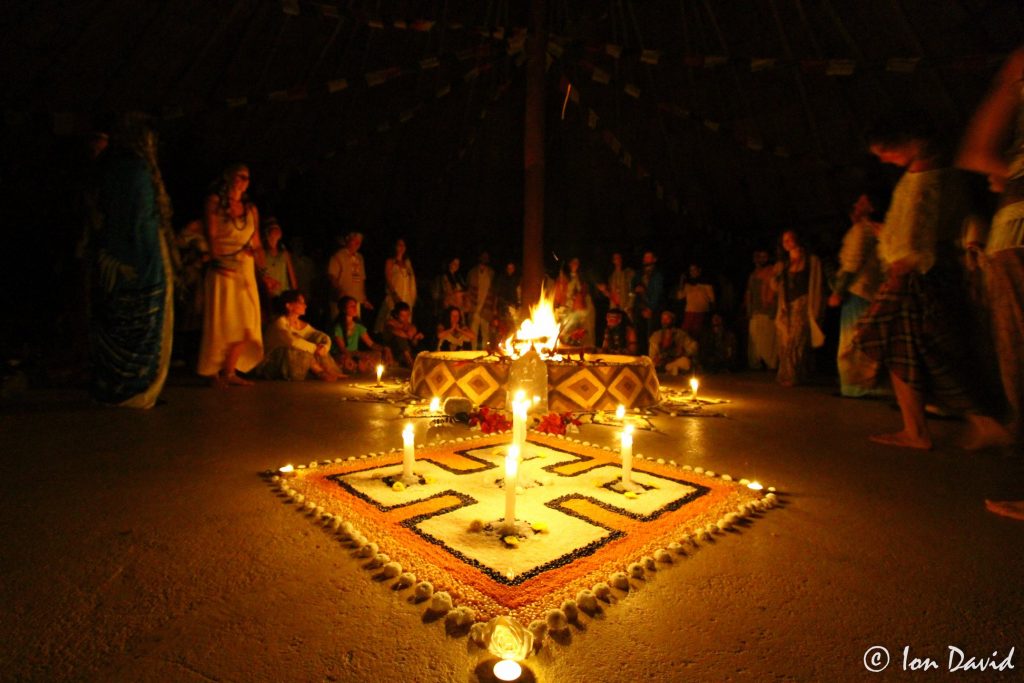
Ayahuasca ceremony is high art form in Brazil | Photo by Ion David
Before We Dive In…Let’s Set a Few Things Straight
This is an article addressing the rapidly expanding gringo ayahuasca market, where non-native ayahuasca consumers and facilitators now outnumber the population of people (both indigenous and mestizo) who consume and serve ayahuasca in the Amazon.
To nip some of the most common objections in the bud:
- We get that skilled and unskilled, good and bad ayahuasqueros exist in South America
- We get that safety and integrity is the foundation for all “good” ayahuasca ceremonies
- We get that the “true shaman and healer” is the plant medicine
- We love and have received profound visions while listening to recorded medicine music, and would choose a great playlist over an unskillfully-managed ceremony any day
The purpose of this article is to highlight:
- What ceremony skills gringo ayahuasca consumers and facilitators might be missing
- Why it’s worthwhile for gringo facilitators to cultivate the subtle art of ayahuasca ceremony
- Why it’s important for discerning ayahuasca consumers to know what “skills” are, as well as what “good” and “great” look like
- And why it’s important to seek out facilitators who are truly dedicated to cultivating the skills required for conducting this profound and subtle healing art in a good way
Also…
“Good” is Relative, “Skill” is Not… & “Style” is an Entirely Different Thing
Before diving into this deep topic, it’s important to make a distinction between “good” and “skilled”. For most ayahuasca consumers who hail from the Global North with limited South American ayahuasca experience, “good” means:
But because ayahuasca is a plant medicine that has been used for hundreds, if not thousands of years, as one of many remedies in a holistic health care system, the individual (the shaman) administering the remedy, was expected to have “skills”.
In the West, we have licensing boards for medical professionals, and our understanding of what a “good doctor” is depends on that person’s skills, knowledge, and experience. Similarly, in the Amazon, shamans were also expected to have knowledge, skills, experience, and be evaluated by their elders before being deemed “ready” to administer medicines.
While there are many lineages and ways of working with ayahuasca in the Amazon, the skills a shaman is expected to have are fairly consistent across ayahuasca lineages as well as shamanic cultures around the world.
Fundamentally, these skills involve the shaman’s ability to:
- direct and move unseen energies
- communicate with spirits, ancestors and guides
- lead a group of people in shared prayer and trance states
- and most importantly… heal
These are the shamanic skills that go into the subtle art of ayahuasca ceremony. Really cultivating those skills can make a “good” facilitator “great”.
It’s also important to clarify…
“Qualified” is Not the Same As “Good”, & Good Is Not “Great”
In the ayahuasca world a lot of emphasis is placed on finding a qualified shaman or facilitator. This is important and necessary – you wouldn’t want to see a doctor who hasn’t gone to med school. However, “qualified” is highly variable, very subjective and should not be confused with “good”. It’s highly variable because different traditions have different criteria to determine when an apprentice is ready to serve a master plant medicine.
Furthermore, with the globalization of ayahuasca, healers are discovering they can earn great money teaching gringos how to work with plant medicines. Some of these curanderos are very generous with granting their students permission to pour. For this reason one’s qualifications might be extremely subjective.
A shaman or facilitator might also be “qualified” but not “good”, because they are an egomaniac, sex predator or abusive. Or they have all the credentials, but their heart isn’t into the work, their icaros are robotic and repetitive… it’s just a “job”.
On the flip side, it’s hard to be “good” at leading ayahuasca ceremony without having had appropriate training.
Even if your music playlist rocks.
This is simply because being a good medicine space-holder requires the bare minimum skills. Like keeping your operating table clean and sterilizing surgical equipment before an operation.
And that works great for a lot of people. But “good” is not “great”.
First off, good is not great.
Basically all that is needed is a good understanding of the medicine, a full knowledge of interactions, good first aid skills, compassion for those in the room, the ability to be aware of what is happening on all levels, and great sensitivity to the effects of the recorded music being played.Knowing basic human psychology and having some skills in trauma release therapies is important for anyone pouring. This can be good, like getting a C or a C+ in school is good.
~ Richard Grossman, L.Ac., O.M.D., Ph.D.
“Great” requires having bona fide shamanic “skills”, in particular the ability to heal. We’ll get into that below.
SIDE NOTE: the Word “Gringo” is Not Offensive in South America – So Don’t Get Your Knickers in a Twist
If you’re offended by the word “gringo”, which is commonly used all over South America in every day language, appearing in tourist business names (hotels, hostels, cafes, restaurants, surf shops) and in Western tourist guides… well don’t be.
In the Amazon, anyone not from there is called a “gringo”. In South America, anyone foreign from another country (particularly those who are not Latino) is a “gringo”. I, a foreigner of Asian descent, am a “gringa”. If I were a young girl in South America, I’d be a “gringita”.
In Latin American culture, it is common, accepted and even a kindness to give people nicknames based on their physical appearance.
“Gringo” is no more racist as calling anyone from any of the Latin American countries from Argentina to Mexico a “Latino”. So just as the the diverse nationalities of Latin America have been grouped (right or wrong) under the term “Latino”, it seems that “Gringo” have come to define foreigners as a group in Latin America.
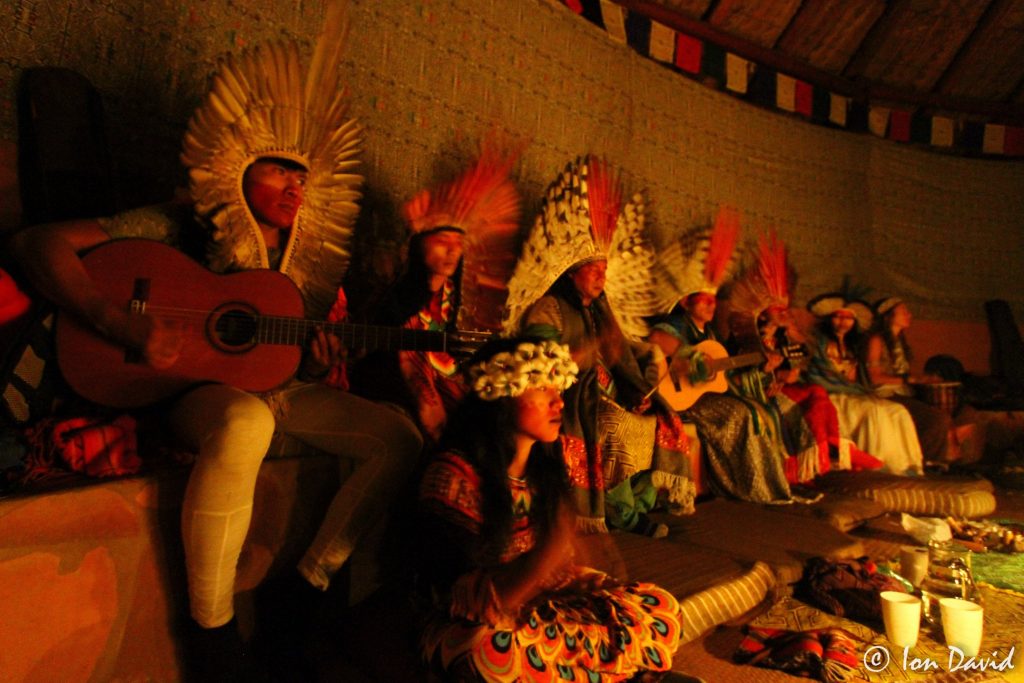
Indigenous shamans from an unbroken lineage lead a music-filled ayahuasca ceremony | Photo by Ion David
3 Reasons Why Most Gringos Fail to Appreciate the Subtle Art of Ayahuasca Ceremony
The truth is, there is a huge divide between the way ayahuasca ceremonies are conducted in the Global North, than in the South, especially where ayahuasca use is permitted and protected, and a thriving arts culture is allowed to emerge.
Much of this is due to the environment of drug prohibition in North America and Europe. It’s simply very difficult to cultivate an illegal, clandestine activity into a high art form, in the same way ayahuasca culture has thrived in places like Brazil. Ayahuasca culture there seems to sprout new medicine musicians, communities, festivals and spiritual centers each day.
Here are 3 main reasons why ayahuasca consumers from the Global North have difficulty discerning ceremony quality and facilitator skills:
1. Obsession with the psychedelic brew.
To gringos, it doesn’t matter that Amazonian plant medicine healing involves the use of many other plant medicines, as well as healing practices. To most gringos, ayahuasca ceremony is all about what’s poured into the cup and whether it gets them off. They care a lot less about who’s pouring the brew, whether the person is qualified at all, or has had any training.
They don’t care if their “shaman” was not so long ago working in the retreat center kitchen, and that she received her initiation not from a Maestro and after months or years of solitary dieta, but from the retreat center owner… because they needed another shaman to serve the steady stream of clients.
Gringo ayahuasca consumers, for the most part, do not care how the indigenous feel about their sacred medicines and ceremonies being co-opted and commercialized. Gringo ayahuasca consumers only care about getting their money’s worth – a soul-shifting psychedelic breakthrough and healing visions. For the average price of $200 per ceremony, the average gringo ceremony participant wants a brew that tastes good and comes with fireworks. It doesn’t matter how authentic the ceremony is, how skilled the shaman is or if the shaman comes from a long line of curanderos.
Ayahuasca brews are highly variable – its taste and visionary qualities are affected by the strength, preparation, and plants used in the concoction. People in the Amazon have a different relationship to ayahuasca. It is sacred medicine, no matter how weak it is or how bad it tastes.
Sadly, if an esteemed elder or wisdom keeper happens to serve a fermented, awful-tasting, and weak ayahuasca brew, most gringo ceremony participants would not have much appreciation for the ceremony, the shaman, or lineage. Most likely, they simply won’t go back.
Gringo participants will, however, return over and over again to a mediocre facilitator who serves a great tasting, strong, and highly visual ayahuasca brew, even if that facilitator isn’t very skilled and plays recorded music off a laptop.
2. Limited access to “good ceremonies” due to prohibition.
Clandestine ayahuasca circles in countries where the plant medicine is illegal are highly variable in quality and structure. Most gringo consumers have a hard enough time finding a circle, let alone a good facilitator.
If the individual happens to find someone reasonably good, there is a tendency to stay with that medicine circle, because it’s where they feel safe and in community. The risk of stepping out into the psychedelic unknown is far too high, whether it’s in a country with no consumer protections or recourse around harm related to the use of illegal substances, or in the Amazon, in a different culture, with a different language, far away from home.
3. The language and cultural barriers can feel daunting.
Most gringo ayahuasca consumers don’t understand Spanish or Portuguese, let alone Amazonian culture. The foreignness of a Maestro ayahuasquero chanting icaros all night long in a dark maloca feels overwhelming, intimidating, or unrelatable to the average gringo in a psychedelic state.
The fact that this Maestro is a seasoned plant medicine doctor, with deep knowledge and decades of experience may be hard to appreciate. For so many gringos, it’s easier to gravitate towards a psychedelic experience that they can relate to, even if its delivery is mediocre, than to appreciate an amazing, and masterful experience delivered in a way they don’t understand.
Ayahuasca Ceremony is a Subtle Art That Requires Shamanic Skills
Most reputable South American shamans and ceremony leaders who come from a country where plant medicines use is permitted and plant medicine culture is thriving, would see most gringo shamans as ranging from mediocre to laughable (or snort-worthy) at best, to a downright affront or insult to the medicine, at worst. “Qualified” or not.
I would say that one’s relationships with plant allies built through dietas would be a central focus to continuously develop. Knowing how to open a ceremony, raise the mareacion, level the mareacion (raise or lower it as necessary), and close a ceremony, as well as how to help people if they are crossed, would also be important.
~ Carlos Tanner, Founder of the Ayahuasca Foundation in Iquitos, Peru
This is because most gringo facilitators are oblivious to the subtle art of ayahuasca ceremony, or simply don’t have the time to spend months or years in the Amazon to master it. While methods and techniques vary from culture to culture, at its core, ayahuasca is a shamanic tool, and shamanism involves the ability to work with and shift subtle energies and unseen forces.
When it comes to ceremonies and music… my experience is primarily with Shipibo curanderos.
Based on that experience I feel that icaros are a highly specific, subtle and potent technology that is often misunderstood and underrated by those not trained to hear/feel their nuance.
I personally love the spontaneous and responsive nature of true icaros- for me the skill comes when a curandero is moved by the energy of their dietas to work spontaneously and precisely through frequency, rhythm and melody to create very specific effects in response to the particular needs of those in the space at that moment…
In that sense, icaros are alive.
~ Skye Cielita Flor, long-term student & facilitator of Shipibo curanderismo in the Mahua-Lopez lineage
Shamanic skills include the ability to:
- Heal and perform psychic surgery. Whether is through the application of other herbal remedies, or sucking illness and negative energy from the body through a limpieza, the ability to heal sick people is a core skill in Amazonian shamanism.
- Skillfully attend to participants who are in difficulty. In most cases, employing shamanic techniques such as smudging, blowing tobacco, or feather brushing is enough to calm an individual in emotional distress. In rarer cases, calming a participant who has gotten violent, disruptive, is attempting to flee, or who is experiencing a health emergency, takes skill, discernment, and experience. An unskilled facilitator (and even a young indigenous paje) can really botch this, and make the situation worse.
- Knowledge of plant medicine healing. Ayahuasca is one of many plants employed in Amazonian shamanism. As in Traditional Chinese Medicine, in Amazonian traditional medicine, a skilled curandero would be able to prescribe personalized healing protocols that draw from a deep knowledge of different plant medicines.
- Cook up potent plant medicine themselves. While brewing ayahuasca can be straight forward and anyone can buy ingredients and find a recipe on the Internet, brewing the medicine is a shamanic work. The energetic vibration, intention and prayers put into the brew by those who make it can be felt by those who drink it.
- Receive sacred songs from the Astral. In the Amazon the more songs a shaman has, the more powerful he is considered to be. Many Amazonian shamans have hundreds, if not thousands, of their own songs and icaros.
- Summon and dispatch spirits. Part of the Amazonian healing paradigm involves calling upon the assistance of helping spirits and elemental forces to support the healing process, as well as protecting the ceremonial space from unwanted entity intrusions.
- Raise or lower the energy of a room using sound. Whether it’s through icaros, songs, or instruments, a skilled ceremony leader will be attuned to the energy of the room, and able to raise or lower the frequency as needed, as well as initiate synchronized group vomiting.
- Guide a group in a shared vision. A skilled shaman, ceremony leader or medicine musician can, can create an experience whereby the participants receive a vision at the same time. Whether it’s the same shared vision is difficult to discern, but when a song or chant ends and everyone gasps and sighs as if something profoundly moving or exquisite just left the room, this is a shared experience of divine vision that is hard to deny.
- Lead a sound-based shamanic journey, without missing a beat. In some of the most intense moments of ceremony you might have multiple people freaking out or vocalizing in some way. A sure sign of skill is if the shaman or facilitator is able to carry their song to the finish line without missing a beat, no matter what chaos has descended upon the room.
- Be the “last one standing”. It takes a lot of energy and strength to lead a group of people in a visionary journey all night long, with prayer, music, song, and chants, and to be attuned to the energetic vibration of the room and each participant. It can be exhausting. The strength and vitality to hold a ceremonial container all night long until sunrise is a skill.
- Restore balance in Nature and harmony in the community. Shamanism has always been about the shaman’s ability to intercede with unseen forces to affect change in the physical world. Shamans were responsible for preserving the culture and maintaining harmony in the community through ritual as well as sage consultation.
A skilled ayahuasca ceremony leader is in tune with all the subtle energies that arise in the space, and is able to work with them in a way that is harmonizing and fluid.
A “good shaman” is TRAINED through years of study, sacrifice, initiation, the passing of tests, observation by elders, completed diets, right relationship, arkanas, transmission, knowledge of remedies and protocols for healing, commitment, surrender, faith, and the blessing of the line for which one was trained under.
What’s most important though, is whether their work sticks – are people healing, growing, advancing, learning, making corrections, walking through new doorways, etc?
A “good shaman” is a guide, because they have gone through rigorous development to be able to get to the other side of many many obstacles in sickness, health, shadow and consciousness. You get what you get, wherever you are is where you are. Phases, stages, levels.
~ Santiparro, Shipibo-trained practitioner, student of Sina & Emilio Ramirez
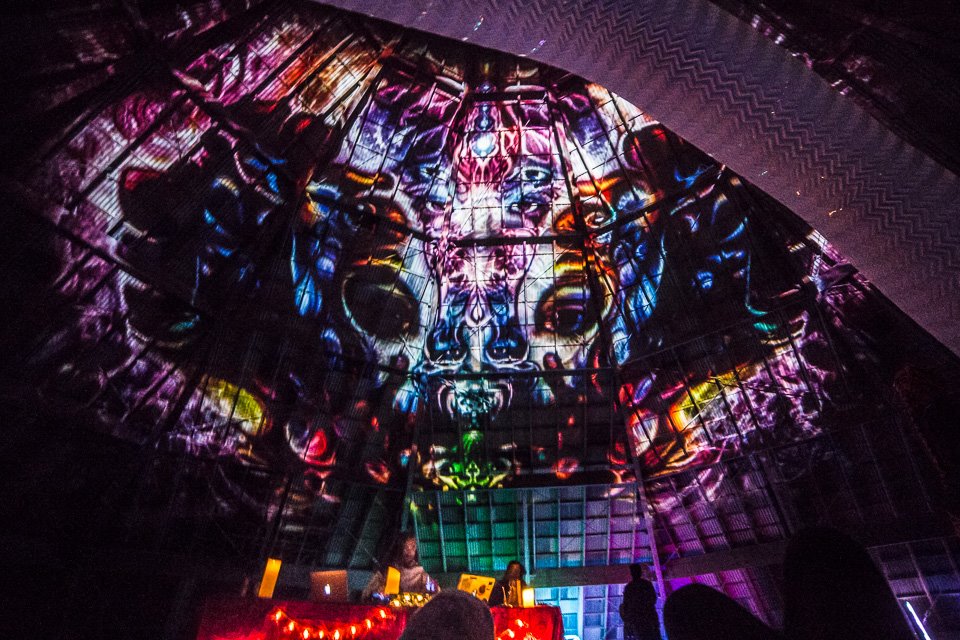
Psychedelic sound journey DJs are a rising expertise in the Psychedelic Renaissance | Chillout dome by Rasmus Rekyl Jorgensen
Why Ayahuasca Ceremonies with Recorded Music is Considered Amateur…Unless You Are a Psychedelic Sound Journey DJ
With the aforementioned skills as being indicative of a shaman’s ability, in South America, a facilitator who relies on recorded music is considered to be an amateur.
Recorded music has no power.
~ Américo Lopez Sanchez, resident Shipibo Maestro at Soltara Healing Center, Costa Rica
Why?
Because, from a South American perspective, that person either hasn’t:
- Received any of his own songs. And shamanic songs are conferred power from the plant teachers and the spiritual realms. Even Santo Daime church padrinhos and madrinhas, while they themselves might not play an instrument, have received hundreds of songs that the Church congregation and band support them in singing.
- Learned how to sing or play an instrument. Sure it can take a while and a lot of ayahuasca drinking to receive a collection of sacred songs. However, a ceremony facilitator can still lead ceremony with medicine circle songs that were received by other people, and indeed many facilitators do just this.
- Mastered the ability to call in spirits. Plant allies, ancestors, teachers, animal guides, are all called into the ceremonial space to assist with the healing work. This is done through icaros, song and prayer.
Sure, one can have profound, exquisite visions with recorded music. But it’s not the same as a skilled shaman or ceremony facilitator creating a live music container, playing music from the heart and songs that are aligned to what’s happening in the room.
Furthermore, ayahuasca culture has expanded and has become more competitive. Twenty years ago there were fewer ayahuasca facilitators, so recorded music was more accepted.
These days, many talented medicine musicians are emerging, and the ayahuasca industry is moving beyond recorded music.
As a musician, DJ and sound journey facilitator, and someone who has sat with many different kinds of spirit plant medicine facilitators and shamans, I would say that if the facilitator is choosing to use a playlist he or she HAS to at least know how to play a few songs on his own, and not just mantras from other people, but also your original medicine songs, and some songs will come improvised in the very moment of the session, and that’s when the real deep magic occurs.
Then, on the other side, if the facilitator doesn’t know how to play a musical instrument nor sing, and wants to use recorded songs, then he still has to be VERY very well-versed in those songs, he should have journeyed with those songs himself to know what kind of emotions they convey, he needs to listen to them over and over again, and study the playlist he is making, make sure all the songs are gentle and with not too many lyrics.
If they want to play a list, then they might as well learn how to mix songs, and do a pre-made mix, but then, again, you really don’t know which song will help that “crying person” in the room at any specific moment, so for that only reason, Plant spirit medicine practitioners should learn how to play at least a single instrument.
Then in other cases I’ve experienced VERY talented musicians, (musiqueros we call them, because they are not real healers (maybe they were once) but lost their gift when they started following the big big money and lost connection to the jungle and its people)…
Even if the leader is a great musiquero, if his heart is not in a good place, the ceremony will suck, literally suck your energy.
~ Maia Balam, musician, DJ & sound journey facilitator
Indeed, it can take a lot of time and effort to learn how to sing and play guitar, and not everyone is cut out to be a musician. And don’t get me wrong – recorded playlist sound journeys do have their place.
My most epic ceremony was to a recorded music playlist which included commercial songs of a spiritual nature. The facilitators had no idea what they were doing and overdosed everyone on a highly visionary anahuasca brew of caapi, chacruna, syrian rue and mimosa. It was chaos and one person was almost sent to the hospital.
Yet it was my most epic, life-changing visionary experience. I certainly wouldn’t have called the facilitators skilled, or the recorded playlist bad. The playlist was fantastic. And the corresponding visions were out of this world.
~ Lorna Liana, publisher of EntheoNation
But if you’re going to lean on recorded music, in order to minimize jarring transitions that can arise when manually selecting music tracks off a laptop all night long, one way to “skill up” would be to learn some DJ skills and become a psychedelic sound journey DJ.
If that’s not your schtick, it may be better to simply set up an 8-hour playlist, serve up some great medicine, click play and Bon Voyage!
My teachers draw a distinction not only between icaros and recordings, but also between icaros and live music that is sung ‘por gusto’ (for pleasure)… they love it when westerners sing pretty songs on their guitars but do not consider it ‘doing the work’ in the same way you do with icaros.
I understand what they mean but have also had profound experiences on my own with well made playlists and know many others who have too.
This is to say nothing of the myriad of other skills that I think are important for those guiding others in this work- which are mainly interpersonal.
~ Skye Cielita Flor, long-term student & facilitator of Shipibo curanderismo in the Mahua-Lopez lineage
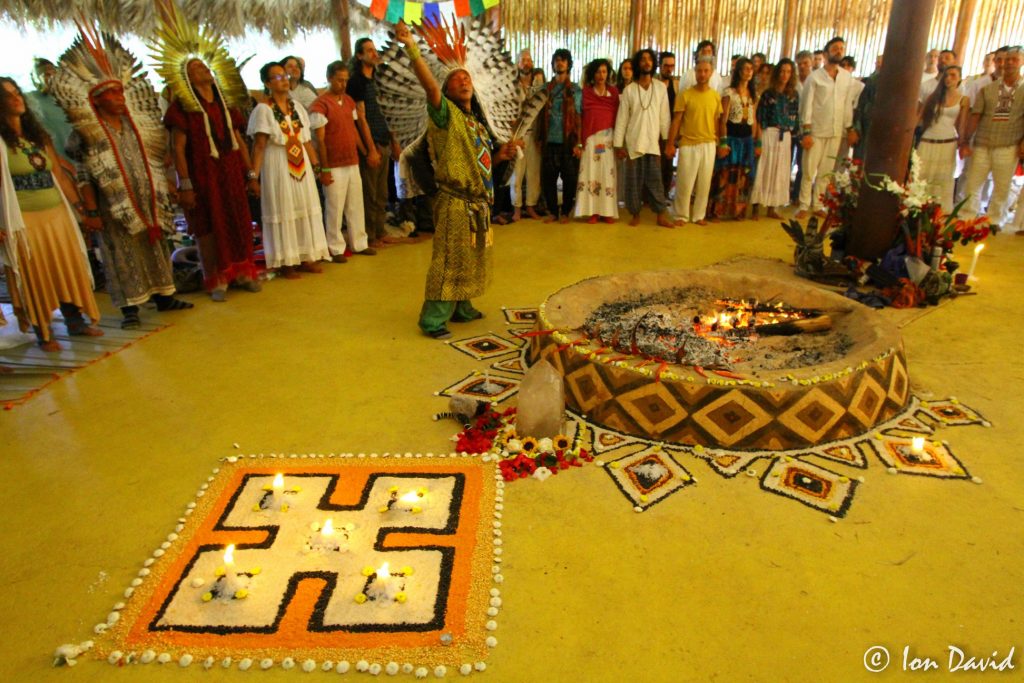
A great ayahuasca ceremony has a beautiful close | Photo by Ion David
What Does Good Ayahuasca Ceremony Facilitation Look Like?
Many of the responses in the ayahuasca forum described “good” ayahuasca ceremony in basic terms. Basic, in that, these criteria are foundational facilitation skills that one must have to even be offering ceremonies. These include:
- Having the compassion, love and integrity needed to offer spiritual healing
- Knowledge of harm reduction, health and medical contraindications, as well as legal risk
- A medical screening process (and not just a release of liability, which offers no legal protection)
- Creating a space and setting that feels safe and loving, so that participants can surrender and trust
- A trained facilitation support team with good interpersonal skills
- Clear orientation on the ceremony structure, as well as the physical space
- Clear, strong opening and closing of the work
- Ability to pour the right amount of medicine for each participant
- The ability to select the right music or chant at the right time, whether it’s live or recorded
- Allowing participants the space to have their experience
- Attentiveness to the participants during the ceremony
- Skill in assisting participants who are having a difficult time
- Offering post-ceremony integration support
For a more in-depth read, many find The Ayahuasca Manifesto, written by a student of Don Jose Campos in a channeled state, to be helpful. You can access it here as a free PDF download in several languages.
A good facilitator is basically a babysitter with some medicine skills.
~ Richard Grossman, L.Ac., O.M.D., Ph.D.
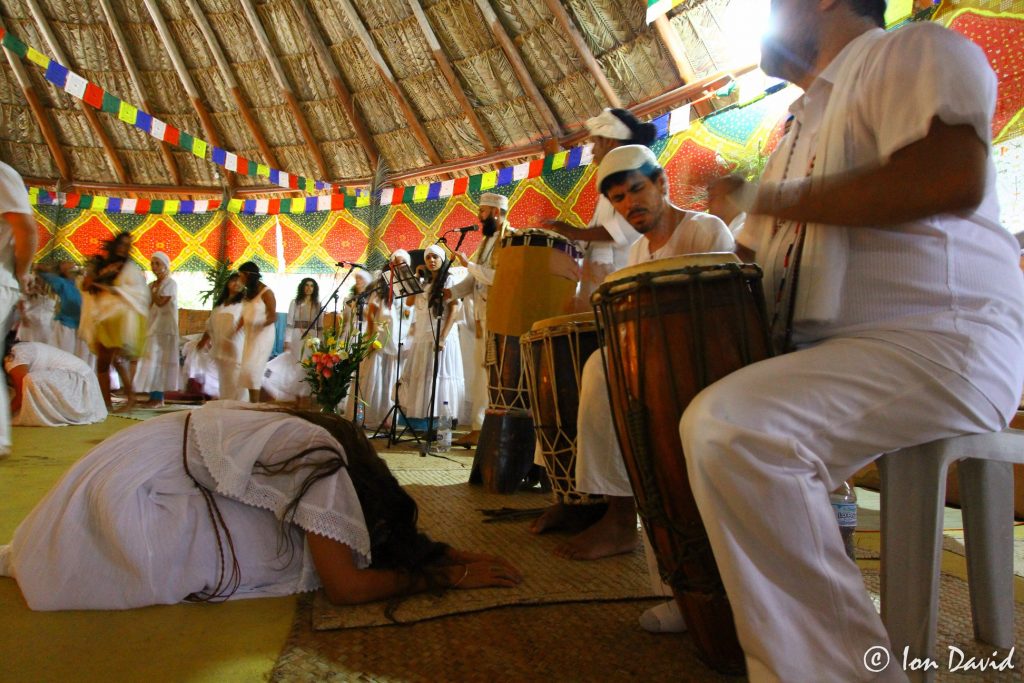
Brazilian Umbandaime ayahuasca ceremonies are all-night mediumship works with live music | Photo by Ion David
What Does “Great” Ayahuasca Ceremony Look Like?
I’ve sat with good North American facilitators, but I haven’t experienced “great” ayahuasca facilitation in the US, in the way that I have in South America, particularly Brazil. There was a time that I took a break from sitting in gringo ceremonies because so many of them were botched or bad, that I opted to drink on my own.
However, I have seen the quality of medicine circles improve with the globalization of ayahuasca and maturing of the market. A few gringo facilitators have emerged who do really lovely, well-held music ceremonies, even if their shamanic healing skills are not developed.
I have my preferences on how I like to experience ayahuasca, and this almost always looks like a musically-rich, culturally-vibrant ceremony with indigenous and non-indigenous ceremony facilitators working together in co-creative alliance. For me, it looks like:
- Top-shelf ayahuasca
- A safe and sacred space free of power dynamics, gender-bias or sexual predation
- A beautiful temple space, with a central sacred fire
- Clean bathrooms and clean buckets
- Indigenous pajes who open the ceremony with their traditional chants, and then transition to songs played with guitar
- A story or prayer by the lead paje in the middle
- Supported by Brazilian medicine musiqueros and an experienced, attentive ceremony support team with many years of experience
- Closing live music from musicians in the community
- The freedom to dance, sit or lie down
- Food and more community live music at the sunrise close
However, while musically-rich, there is very little doctoring in these kind of all-night live concert music journeys.
For a curanderismo-style ceremony, “great” might look like this:
To be a great facilitator, we’re treading into the realm of the healer. A healer utilizes the medicine as both an entry point into deeper understanding of the patient(s) as well as, and more importantly, guiding the patient into their own understanding of why they are out of harmony. In this tradition it’s done with songs, icaros, and live music.
So a great ceremony leader must be at least a very good singer with many icaros and medicine songs. A big plus to have mastery over some other “shamanic” instruments such as flutes, khomus, didgeridoo, drum, chakapa, rattles, etc. And to be able to use these instruments to affect changes in the psychological, spiritual, and physical state of the people in the ceremony, and to do that consciously.
A great facilitator should also have a good understanding of anatomy, physiology, psychology, and pathology. We’re getting into doctor territory here, but if a facilitator has no idea where the liver is (or any other organ) what it’s function is, what can go wrong with it, what plants help it to heal, etc., they are playing at being healers, not being a real healer.
They should also, especially now, understand trauma and how to safely release it so that the patient does not get re-traumatized by reliving horrible experiences without expert guidance and skill.
They should be able to recognize the signs of hidden and repressed traumas and know when to go in and when to just trust the process – and to be able to see if the patient is in deep avoidance of something that is needed to be gently and safely brought to light.
They need the deepest levels possible of compassion, understanding, kindness, and patience.
Able to work with people in the way and time that they need it and not to push people for whom being pushed would be harmful in order to satisfy their own ego.
They need full understanding of Northern pharmaceutical and herbal medicines, or at least the ability to find out what is dangerous with Aya.
They need excellent communication skills to help people process what happened post and in-between ceremonies.
Perhaps the most difficult is that they need to know when to say no to someone who wants to attend the ceremony, for whom ceremony could be disadvantageous or even dangerous.
Having mastery or at least competence in other healing modalities is certainly helpful.
They need incredible assistants.
They need great medicine.
They need to be fearless, especially in those moments of ceremony when things go wonky. Ideally, of course, they won’t, but it happens.
They need to be incredibly dedicated to the process of ceremony, and continue the ceremony, no matter what is going on in their personal or inner life, and to keep their personal and inner life from interfering in their competence.
They need to love what they do more than anything else, except their spouse and family.
They must know how to protect the space, both from external attacks (real or imaginary), and from the stuff people release during ceremony.
And CPR and first aid.
Being a mystic isn’t shabby either.
Most importantly, a heart full of and committed to love.
~ Richard Grossman, L.Ac., O.M.D., Ph.D.
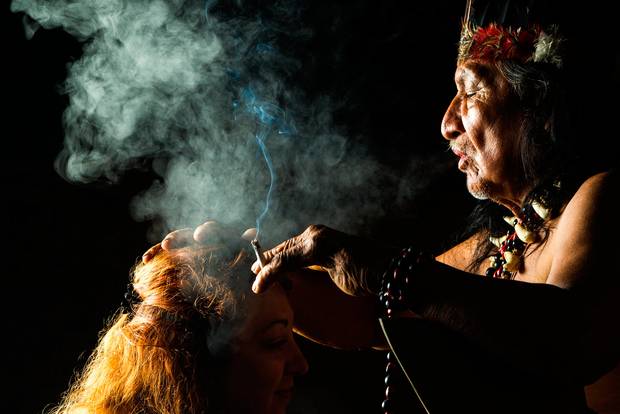
Finally – Great Ceremony Skills Mean Little if the Leader is Abusive
While ayahuasca ceremony is evolving into a high shamanic art form, great ceremony skills mean very little if the ceremony leader is abusive. Sadly, South American culture carries a lot of patriarchal baggage, and many indigenous and mestizo shamans are, at best, oblivious what is considered to be consent in the West, and at worse, prone to engaging in abuses of power, as well as sexual predation.
For this reason, deeply researching your ayahuasca shaman or facilitator, no matter how “famous” the person might be, is always an important step.
I honestly wish there were more “traditionalists” I could send people to in different parts of the world or more native south Americans who are in their integrity. I think it is important we are all tolerant of the different ways that people are going about this, from Santo Daime, to all the different Amazonian ways and bush wackers like myself who might be emphasing the use of Syrian Rue from Iran and acacias from Australia!
~ Julian Palmer, author, facilitator, & creator of changa
At the end of the day, you are much better off with a good, C+ medicine facilitator or space holder; rather than an epic ceremony leader who has all the shamanic bells and whistles, as well as training in medicine, but who is easily corrupted by sex, money and power… and leaves a trail of trauma in his wake.
Image Credits:
- “Melodías Ancestrales” by Luis Tamani
- Condor Eagle Festival by Ion David
- Chillout Dome Sound Journey by Rasmus Rekyl Jorgensen
Lorna Liana is a new media strategist and lifestyle business coach to visionary entrepreneurs. She travels the world while running her business as a digital nomad. Lorna’s boutique agency provides “done for you” web design, development and online marketing services for social ventures, sustainable brands, transformational coaches and new paradigm thought leaders. She is also a personal development junkie, and 20 year practitioner of shamanism, with extensive training in Tibetan Bon Shamanism and the ayahuasca traditions of the Amazon Basin.
A self-professed ayahuasca snob and perennial ayahuasca tourist, Lorna has been drinking ayahuasca since 2004. She’s been in approximately 150 ayahuasca ceremonies (from terrible to fantastic), and tasted wide variety of ayahuasca brews (from awful to exquisite).
Her ayahuasca experience spans 30+ different shamans and facilitators, 7 indigenous tribes, several Brazilian churches, and a host of neo-shamanic circles, in Peru, Ecuador, Brazil, Europe, the US, and Asia.
Through this widely-varied background, she hopes to shed some perspective on the globalization of ayahuasca.

Thank you for sharing this Lorna! As a Gringo married to a Latina I’ve been drawn more and more into the celebration of indigenous people/customs – and have spent too much time in ceremony with westerner shaman. I’m going to change that now. Gracias!
What an article. I’m sure we’ll meet.
Thank you.
Ned